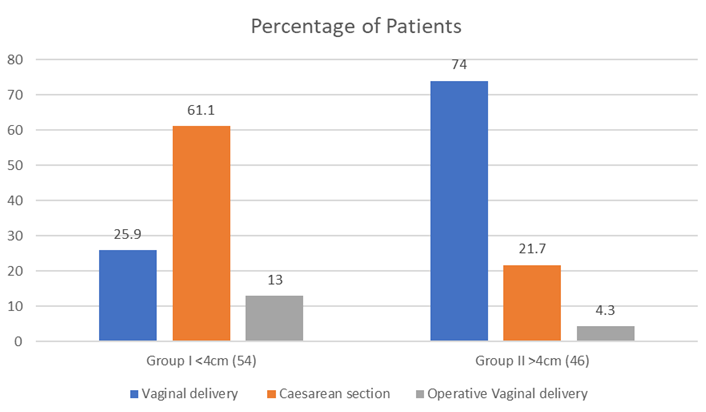A Prospective Study on the Relationship Between Cervical Dilatation at Initial Presentation in Labor and Subsequent Outcome
Abstract
Background: Cervical dilatation at the initial presentation in labor is an important factor in predicting labor progression, maternal and neonatal outcomes. This relationship helps clinicians to assess the likelihood of a timely delivery, the need for medical interventions, and possible complications. Objectives: The aim of the study was to evaluate the relationship between cervical dilatation at initial presentation in labor and subsequent outcome. Methods: This prospective study was carried out in the Department of Obstetrics & Gynaecology, Dhaka Medical College & Hospital, Dhaka, Bangladesh, during July 2006 to June 2007. A total of 100 patients were selected at random basis admitted with labor pain. Statistical analyses of the results were be obtained by using window-based Microsoft Excel and Statistical Packages for Social Sciences (SPSS-24). Results: The age distribution of the patients was (1%) 11 to 15 years, (25%) 16 to 20 years, (40%) 21 to 25 years, (22%) 26 to 30 years and (9%) 31 to 35 years. And (3%) were older than 36 years. The majority of the population ranges in age from 21 to 25 years. In our study, Group I: Cervical dilatation (os) <4 cm and Group II: Cervical dilatation (os) > 4 cm. Dilatation of Cervix on admission where 54(54%) were Group – I <4 cm, 46(46%) ware Group – II ≥ 4cm. Most of the populations belong to Group – I <4 cm group. According to Parity distribution of the patients, 38 (79.2%) group I and 10 (20.8%) group II patients were nulliparous, whereas 16 (30.8%) group I and 36 (69.2%) group II patients were multiparous. Conclusion: Cervical dilatation at the initial presentation in labor is a crucial factor in determining labor management and predicting outcomes. Advanced dilatation is generally associated with quicker labor progression, fewer interventions, and better maternal and neonatal outcomes, while minimal dilation may require more vigilant monitoring and management to ensure safe delivery.
Downloads
References
Bailit JL, Dierker L, Blanchard MH, Mercer BM. Outcomes of women presenting in active versus latent phase of spontaneous labor. Obstet Gynaecol 2005 Jan; 105(1): 77-9.
Holmes P, Oppenheimer LW, Wen SW. The relationship between cervical dilatation at initial presentation in labor and subsequent intervention BrJ Obstet Gynaecol 2001 Nov; 108(11): 1120-4.
Nkyekyer K. Arrival in the labor ward in second stage of labor – any prognostic significance? East Afr Med J. 1998 May; 75(5): 282-7.
Melmed H, Evans M. Predictive value of cervical dilatation rate. BrJ Obstet Gynaecol 1976 May.
Demianczuk NN, Hunter DJ, Taylor DW. Trial of labor ofter previous cesarean section: prognostic indicators of outcome. Am J Obstet Gynecol 1982 Mar 15; 142 (6 pt I): 640-2.
Archie Carol L, Biswas Manoj K. The course & conduct of normal labor & delivery. Current obstetric & Gynaecologic diagnosis and treatment. 9th ed. McGraw-Hill Companies; 2003. 213 – 221.
Calder A.A. Normal labor. Dewhurst’s textbook of Obstetrics and Gynaecology for postgraduates. 6th ed. Blackwell Science Ltd; 1999. 242 - 251.
Johanson R. Malposition, malpresentation and cepnalopelvic disproportion. Dewhurst’s textbook of Obstetrics and Gynaecology for postgraduate’s 6th ed. Blackwell Science Ltd; 1999. 277 – 289.
Nahar Khairun. Indication of caesarean section, a study of 100 cases in DMCH. Bangladesh College of Physicians & Surgeons Dissertation 1997;94.
Fergal D Malone, M. Grey, David Chelmow, J. Strong. Prolonged labor: Lesson from active management of labor. Am J Obstet & Gynaecol 1996; 88:211-215.
Paul Holmes, Lawrence W, Shiwe Wen. The relationship between cervical dilatation and subsequent outcome. Br J Obstet & Gynaecol 2001; 108:1120-1124.
Leitch CR, Walker JJ. The rise in caesarean section rate: the same indication but a lower threshold. Br J Obstet Gynaecol 1998; 105:621-626.
Polo Ana, Lisbeth, Herrera, Martin. Complication of labor & delivery. Current obstetric & Gynaecologic diagnosis and treatment. 9th ed. McGraw-Hill Companies; 2003. 466 – 476.
Jahan Rownak. Clinical profile & outcome of labor in primi in a series of 100 cases in IPGMR. BCPS Dissertation 1996; 110.
Maghoma J, Buchmann EJ. Maternal & fetal risk factor associated with prolonged latent phase of labor. Br J Obstet Gynaecol 2002;22(1):16-19.
Oswyn G, Vince JD, Friesen H. Perinatal asphyxia at Port Moresby General hospital: a study of incidence, risk factors & outcome. PNG Med J. 2000;43(1-2):110-120.



























